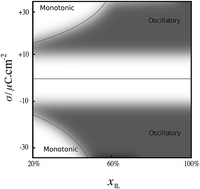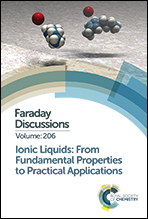Interfacial structure and structural forces in mixtures of ionic liquid with a polar solvent†
Abstract
Many applications of ionic liquids involve their mixtures with neutral molecular solvents. The chemical physics of these high-concentration electrolytes, in particular at interfaces, still holds many challenges. In this contribution we begin to unravel the relationship between measurements of structural (‘solvation’) forces in mixtures of ionic liquid with polar solvent and the corresponding structure determined by molecular dynamics simulations of the same mixtures. In order to make the quantitative link between experiments with mica surfaces and simulations with fixed-charge surfaces, we present an experimental procedure for determining the effective surface charge on mica in ionic liquid. We find that a structural cross-over recently inferred from force measurements appears to be supported by the simulations: at the cross-over, the charge-oscillatory structure switches to charge-monotonic, and solvent layering becomes dominant. Finally, we map out a phase diagram in composition-surface charge space delineating regions of charge-oscillatory interfacial structure and regions of charge-monotonic decay. We note that these features of structure and oscillatory forces are distinct from (acting simultaneously with) the recently reported longer range monotonic forces arising from anomalously long bulk screening lengths in high-concentration electrolytes.

- This article is part of the themed collection: Ionic liquids: from fundamental properties to practical applications


 Please wait while we load your content...
Please wait while we load your content...